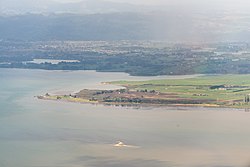Karaka, New Zealand
Karaka | |
|---|---|
 Aerial view of northern Karaka, with Papakura and the Hunua Ranges in the background. | |
 | |
| Coordinates: 37°6′S 174°52′E / 37.100°S 174.867°E | |
| Country | New Zealand |
| Region | Auckland Region |
| Territorial authority | Auckland Council |
| Ward | Franklin ward |
| Board | Franklin Local Board |
| Electorates | |
| Area | |
• Total | 86.68 km2 (33.47 sq mi) |
| Population (June 2024)[2] | |
• Total | 3,180 |
| • Density | 37/km2 (95/sq mi) |
| Postcode | 2120 |
| Area code | 09 |
Karaka is a small rural area in the south of Auckland, New Zealand. Formerly part of Franklin District and under the authority of the Franklin District Council, it is now part of Auckland Council (under the Franklin Local Board[3]) following the amalgamation of the Auckland region's councils.
The area includes Karaka Lakes and Karaka Harbourside Estate.
History
[edit]Between 1870 and 1900, Karaka, Waiuku and the Āwhitu Peninsula were major centres for the kauri gum industry.[4]
Government
[edit]Karaka was originally governed by the Karaka Road District Board before amalgamating with Franklin County in 1918.[5]
Demographics
[edit]Kingseat-Karaka statistical area covers 86.68 km2 (33.47 sq mi)[1] and had an estimated population of 3,180 as of June 2024,[2] with a population density of 37 people per km2.
| Year | Pop. | ±% p.a. |
|---|---|---|
| 2006 | 2,496 | — |
| 2013 | 2,550 | +0.31% |
| 2018 | 2,904 | +2.63% |
| Source: [6] | ||
Kingseat-Karaka had a population of 2,904 at the 2018 New Zealand census, an increase of 354 people (13.9%) since the 2013 census, and an increase of 408 people (16.3%) since the 2006 census. There were 936 households, comprising 1,488 males and 1,416 females, giving a sex ratio of 1.05 males per female. The median age was 41.6 years (compared with 37.4 years nationally), with 588 people (20.2%) aged under 15 years, 465 (16.0%) aged 15 to 29, 1,464 (50.4%) aged 30 to 64, and 390 (13.4%) aged 65 or older.
Ethnicities were 85.3% European/Pākehā, 13.9% Māori, 3.9% Pacific peoples, 7.0% Asian, and 1.9% other ethnicities. People may identify with more than one ethnicity.
The percentage of people born overseas was 16.1, compared with 27.1% nationally.
Although some people chose not to answer the census's question about religious affiliation, 52.4% had no religion, 34.8% were Christian, 1.2% had Māori religious beliefs, 0.6% were Hindu, 0.8% were Muslim, 0.6% were Buddhist and 2.4% had other religions.
Of those at least 15 years old, 522 (22.5%) people had a bachelor's or higher degree, and 339 (14.6%) people had no formal qualifications. The median income was $44,200, compared with $31,800 nationally. 699 people (30.2%) earned over $70,000 compared to 17.2% nationally. The employment status of those at least 15 was that 1,284 (55.4%) people were employed full-time, 369 (15.9%) were part-time, and 60 (2.6%) were unemployed.[6]
Economy
[edit]Karaka is now primarily a rural town associated with thoroughbred horse studs, dairy farming and sheep farming. Karaka is the location of the thoroughbred yearling sales at New Zealand Bloodstock Karaka Sales Complex which is associated with the Karaka Million race meeting at Ellerslie. Westbury Stud and Haunui Farm are both located in Karaka.[7]
Marae
[edit]The Whātāpaka Marae and its meeting house, named Tamaoho, is a traditional meeting ground for local Māori. Three Waikato Tainui hapū are associated with the marae, primarily Ngāti Tamaoho, and secondarily Ngāi Tai and Ngāti Koheriki.[8][9][non-tertiary source needed]
Education
[edit]Karaka School and Te Hihi School are coeducational full primary schools (years 1–8) with rolls of 237 and 169 students, respectively.[10][11] Karaka School celebrated its 75th jubilee in 1978.[12] Te Hihi School opened in 1914.[13]
Rolls are as of August 2024.[14]
Public secondary education is provided in the nearby towns of Papakura and Pukekohe.
References
[edit]- ^ a b "ArcGIS Web Application". statsnz.maps.arcgis.com. Retrieved 27 November 2023.
- ^ a b "Aotearoa Data Explorer". Statistics New Zealand. Retrieved 26 October 2024.
- ^ "Franklin Local Board". Retrieved 26 March 2013.
- ^ Hayward, Bruce W. (1989). Kauri Gum and the Gumdiggers. The Bush Press. p. 5. ISBN 0-908608-39-X.
- ^ The Heritage Studio (July 2017). Franklin County Council Chambers (Former) (PDF) (Report). Auckland Council.
- ^ a b "Statistical area 1 dataset for 2018 Census". Statistics New Zealand. March 2020. Kingseat-Karaka (161400). 2018 Census place summary: Kingseat-Karaka
- ^ Karaka, New Zealand tourism.net.nz Retrieved December 2011
- ^ "Whātāpaka". Māori Maps. Te Potiki National Trust. Retrieved 24 August 2019.
- ^ "Ngāti Tamaoho: hapū and marae". Te Kāhui Māngai. Te Puni Kōkiri. Retrieved 24 August 2019.
- ^ Education Counts: Karaka School
- ^ Education Counts: Te Hihi School
- ^ "Collections record: A sense of history : Karaka School 75th jubilee, 3rd-5th March 1978". Auckland Museum. Retrieved 20 September 2020.
- ^ "Welcome to Te Hihi School". Te Hihi School. Retrieved 20 September 2020.
- ^ "New Zealand Schools Directory". New Zealand Ministry of Education. Retrieved 17 September 2024.
